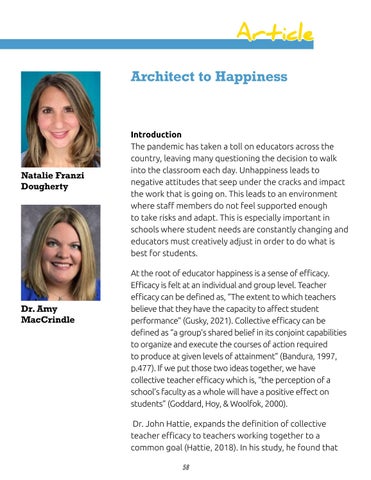Article Architect to Happiness
Natalie Franzi Dougherty
Dr. Amy MacCrindle
Introduction The pandemic has taken a toll on educators across the country, leaving many questioning the decision to walk into the classroom each day. Unhappiness leads to negative attitudes that seep under the cracks and impact the work that is going on. This leads to an environment where staff members do not feel supported enough to take risks and adapt. This is especially important in schools where student needs are constantly changing and educators must creatively adjust in order to do what is best for students. At the root of educator happiness is a sense of efficacy. Efficacy is felt at an individual and group level. Teacher efficacy can be defined as, “The extent to which teachers believe that they have the capacity to affect student performance” (Gusky, 2021). Collective efficacy can be defined as “a group’s shared belief in its conjoint capabilities to organize and execute the courses of action required to produce at given levels of attainment” (Bandura, 1997, p.477). If we put those two ideas together, we have collective teacher efficacy which is, “the perception of a school’s faculty as a whole will have a positive effect on students” (Goddard, Hoy, & Woolfok, 2000). Dr. John Hattie, expands the definition of collective teacher efficacy to teachers working together to a common goal (Hattie, 2018). In his study, he found that 58












